Abstract
Eight monoclonal antibodies were selected from BALB/c mice immunized with two different monoclonal anti-idiotypic antibodies recognizing two discrete idiotopes characteristic of the anti-poly(Glu60Ala30Tyr10) (GAT) antibody response. These monoclonal antibodies were previously classified as Ab1 (anti-GAT-like) and Ab3 (anti-anti-idiotype) on the basis of expression of the public idiotypic specificity (p.GAT) studied with a xenogeneic serum, anti-GAT activity, and expression of various public idiotopes. All the heavy chain variable region (VH) sequences from Ab1 are nearly identical to the VH sequences of Ab1 anti-GAT monoclonal antibodies. The same type of results has been found with the Ab1 kappa light chain variable region (V kappa) sequences. Confirming our classification, Ab3 VH and V kappa sequences were found to be completely different from Ab1 VH and V kappa sequences. The Ab1 diversity (D) regions are different from one another and different from the D regions found on monoclonal anti-GAT antibodies but function similarly. These D regions are not simply derived from already described D genes. Finally, our results suggest that in the anti-GAT response VH and V kappa sequence are mainly responsible for idiotype expression.
Full text
PDF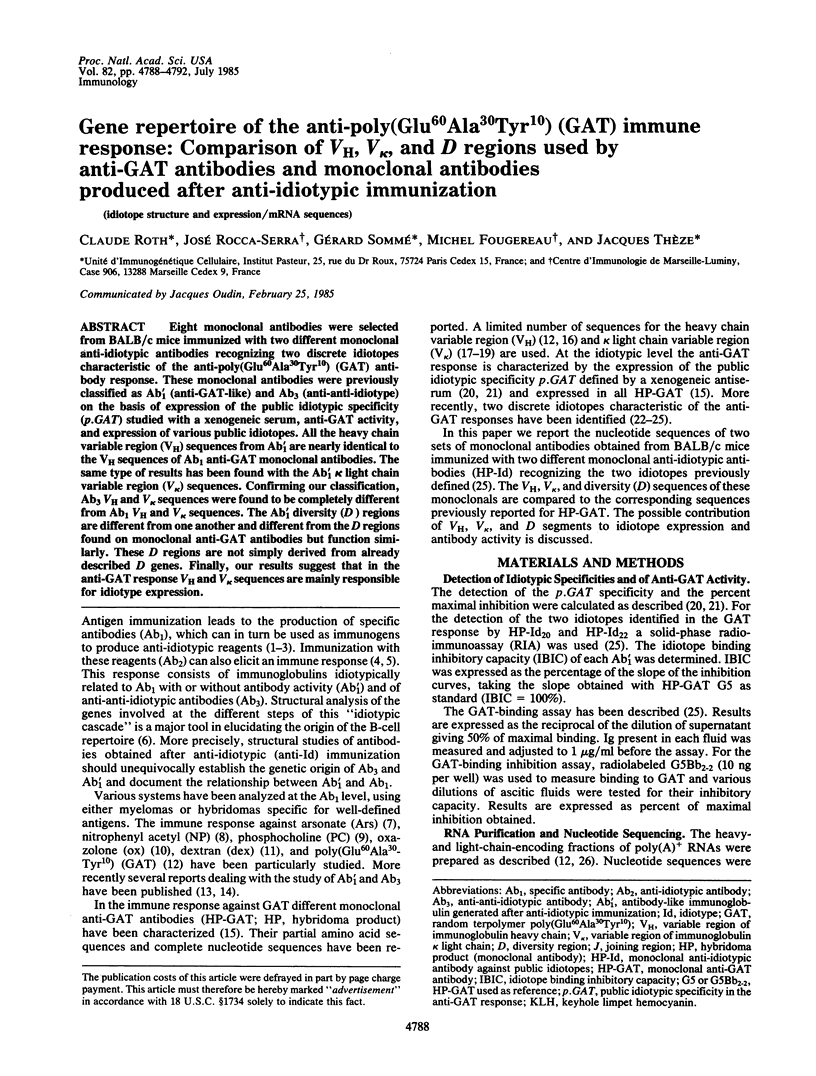
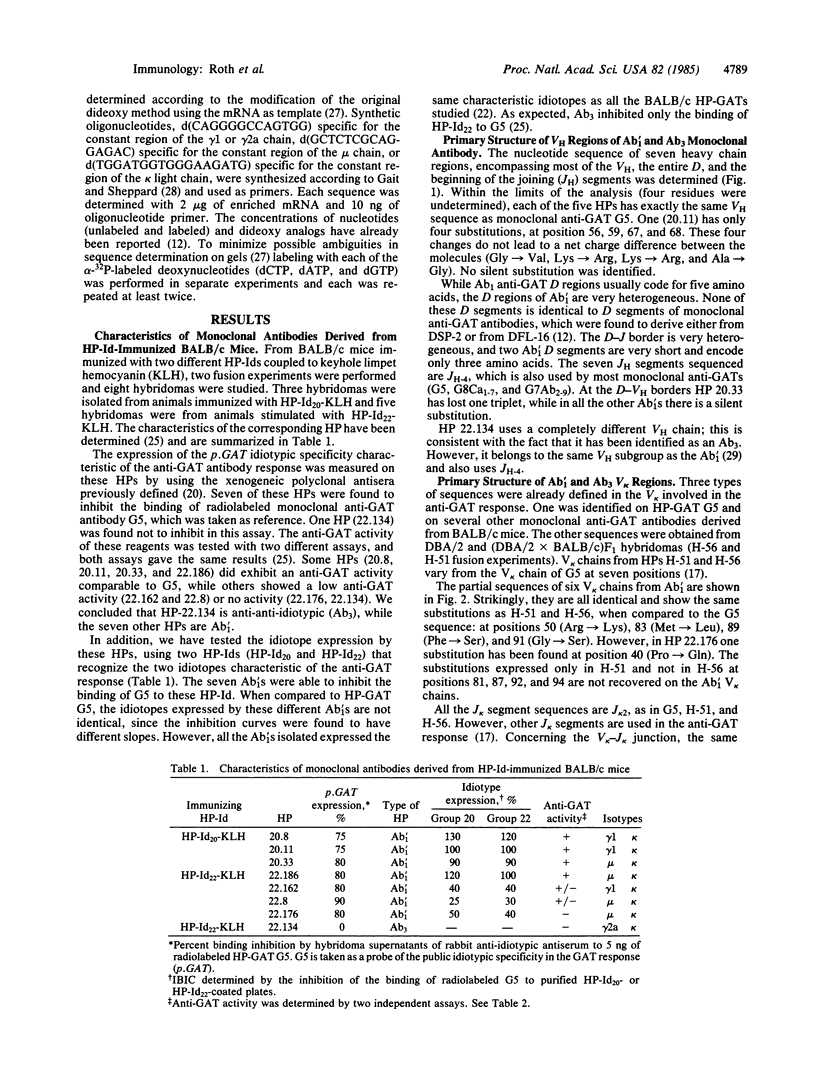
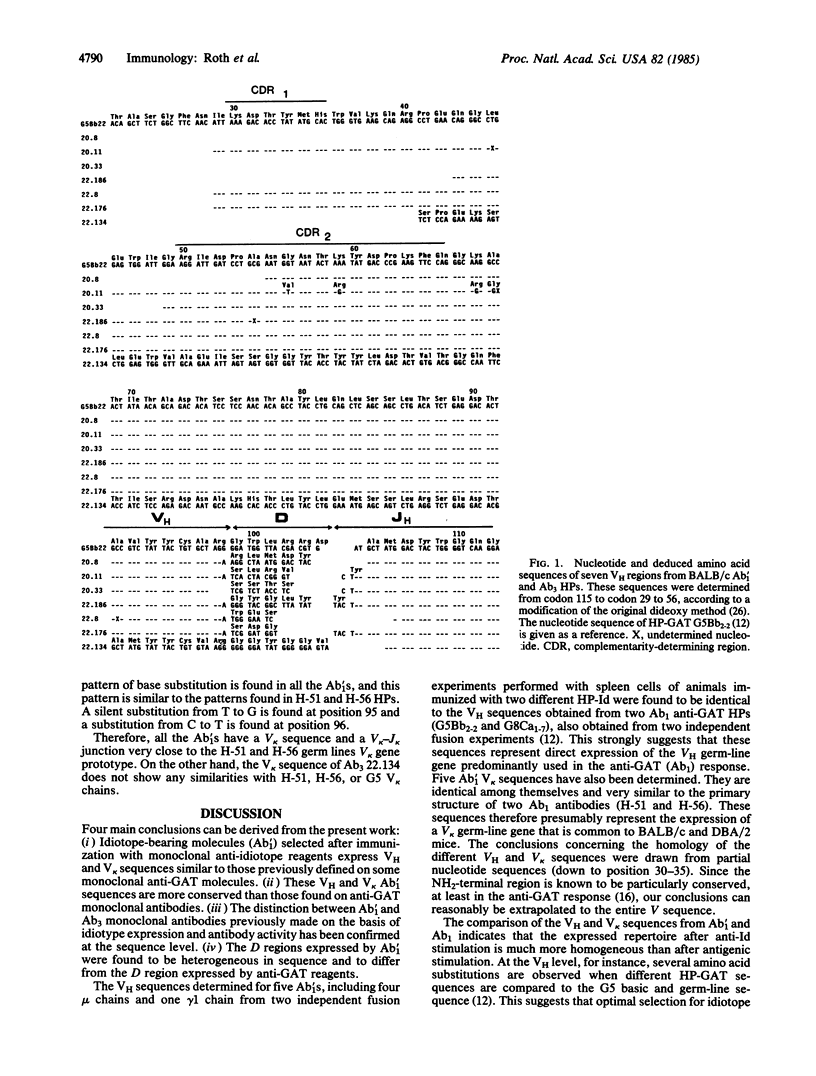
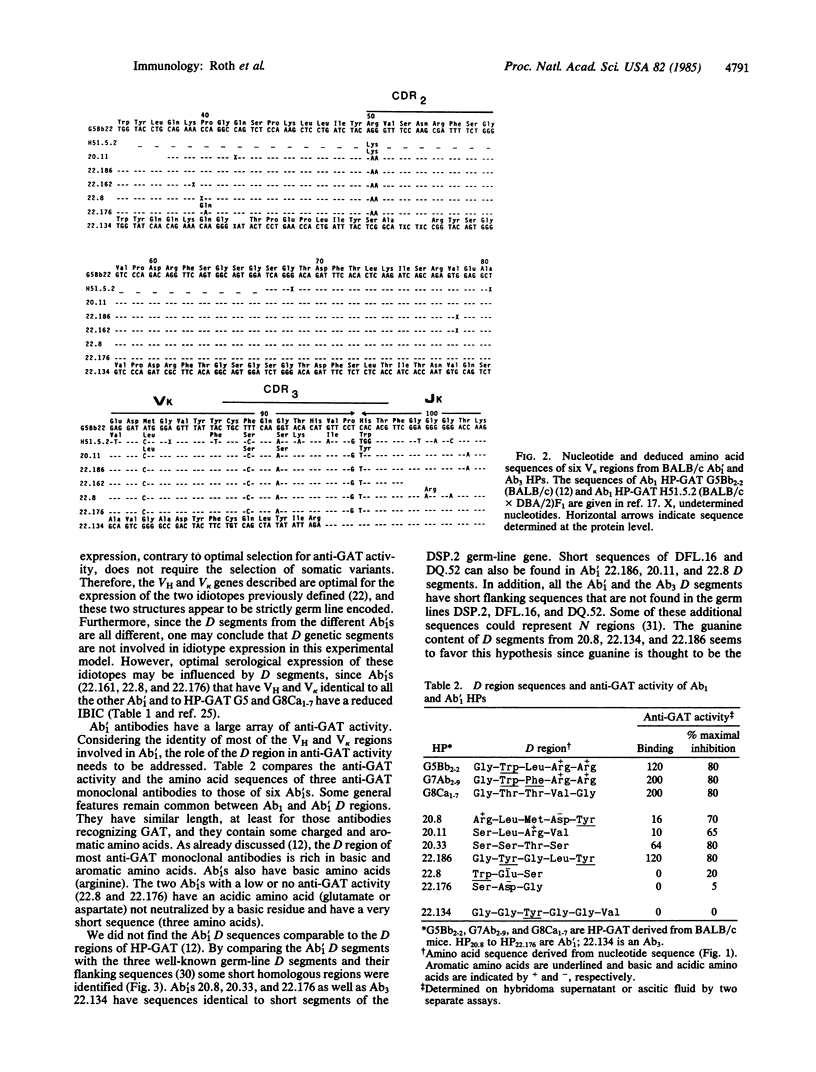
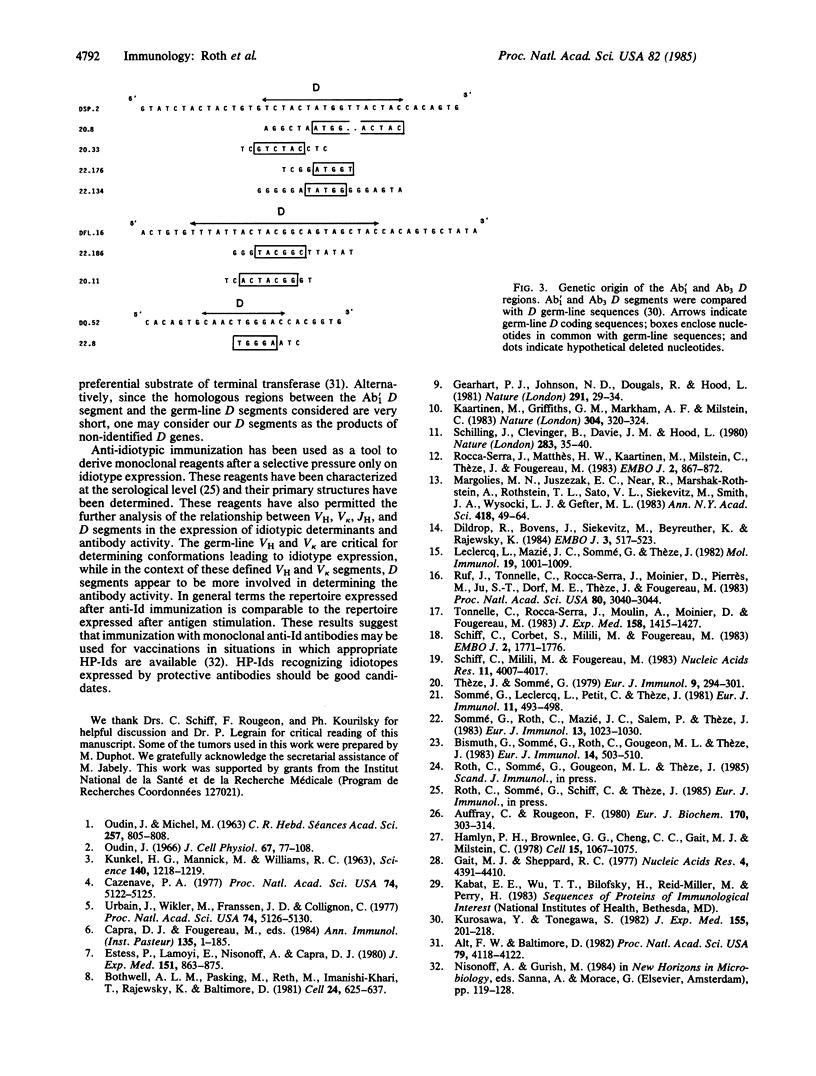
Selected References
These references are in PubMed. This may not be the complete list of references from this article.
- Alt F. W., Baltimore D. Joining of immunoglobulin heavy chain gene segments: implications from a chromosome with evidence of three D-JH fusions. Proc Natl Acad Sci U S A. 1982 Jul;79(13):4118–4122. doi: 10.1073/pnas.79.13.4118. [DOI] [PMC free article] [PubMed] [Google Scholar]
- Auffray C., Rougeon F. Purification of mouse immunoglobulin heavy-chain messenger RNAs from total myeloma tumor RNA. Eur J Biochem. 1980 Jun;107(2):303–314. doi: 10.1111/j.1432-1033.1980.tb06030.x. [DOI] [PubMed] [Google Scholar]
- Bismuth G., Sommé G., Roth C., Gougeon M. L., Thèze J. Poly(Glu60,Ala30,Tyr10) (GAT)-specific T cells do not express B cell public idiotopes but can be primed by monoclonal anti-idiotypic antibodies. Eur J Immunol. 1984 Jun;14(6):503–510. doi: 10.1002/eji.1830140605. [DOI] [PubMed] [Google Scholar]
- Bothwell A. L., Paskind M., Reth M., Imanishi-Kari T., Rajewsky K., Baltimore D. Heavy chain variable region contribution to the NPb family of antibodies: somatic mutation evident in a gamma 2a variable region. Cell. 1981 Jun;24(3):625–637. doi: 10.1016/0092-8674(81)90089-1. [DOI] [PubMed] [Google Scholar]
- Cazenave P. A. Idiotypic-anti-idiotypic regulation of antibody synthesis in rabbits. Proc Natl Acad Sci U S A. 1977 Nov;74(11):5122–5125. doi: 10.1073/pnas.74.11.5122. [DOI] [PMC free article] [PubMed] [Google Scholar]
- Dildrop R., Bovens J., Siekevitz M., Beyreuther K., Rajewsky K. A V region determinant (idiotope) expressed at high frequency in B lymphocytes is encoded by a large set of antibody structural genes. EMBO J. 1984 Mar;3(3):517–523. doi: 10.1002/j.1460-2075.1984.tb01840.x. [DOI] [PMC free article] [PubMed] [Google Scholar]
- Estess P., Lamoyi E., Nisonoff A., Capra J. D. Structural studies on induced antibodies with defined idiotypic specificities. IX. Framework differences in the heavy- and light-chain-variable regions of monoclonal anti-p-azophenylarsonate antibodies from A/J mice differing with respect to a cross-reactive idiotype. J Exp Med. 1980 Apr 1;151(4):863–875. doi: 10.1084/jem.151.4.863. [DOI] [PMC free article] [PubMed] [Google Scholar]
- Gait M. J., Sheppard R. C. Rapid synthesis of oligodeoxyribonucleotides. II. Machine-aided solid-phase syntheses of two nonanucleotides and an octanucleotide. Nucleic Acids Res. 1977 Dec;4(12):4391–4410. doi: 10.1093/nar/4.12.4391. [DOI] [PMC free article] [PubMed] [Google Scholar]
- Gearhart P. J., Johnson N. D., Douglas R., Hood L. IgG antibodies to phosphorylcholine exhibit more diversity than their IgM counterparts. Nature. 1981 May 7;291(5810):29–34. doi: 10.1038/291029a0. [DOI] [PubMed] [Google Scholar]
- Hamlyn P. H., Browniee G. G., Cheng C. C., Gait M. J., Milstein C. Complete sequence of constant and 3' noncoding regions of an immunoglobulin mRNA using the dideoxynucleotide method of RNA sequencing. Cell. 1978 Nov;15(3):1067–1075. doi: 10.1016/0092-8674(78)90290-8. [DOI] [PubMed] [Google Scholar]
- Kaartinen M., Griffiths G. M., Markham A. F., Milstein C. mRNA sequences define an unusually restricted IgG response to 2-phenyloxazolone and its early diversification. 1983 Jul 28-Aug 3Nature. 304(5924):320–324. doi: 10.1038/304320a0. [DOI] [PubMed] [Google Scholar]
- Kunkel H. G., Mannik M., Williams R. C. Individual Antigenic Specificity of Isolated Antibodies. Science. 1963 Jun 14;140(3572):1218–1219. doi: 10.1126/science.140.3572.1218. [DOI] [PubMed] [Google Scholar]
- Kurosawa Y., Tonegawa S. Organization, structure, and assembly of immunoglobulin heavy chain diversity DNA segments. J Exp Med. 1982 Jan 1;155(1):201–218. doi: 10.1084/jem.155.1.201. [DOI] [PMC free article] [PubMed] [Google Scholar]
- Leclercq L., Mazié J. C., Sommé G., Thèze J. Monoclonal anti-GAT antibodies with different fine specificities express the same public idiotype. Mol Immunol. 1982 Aug;19(8):1001–1009. doi: 10.1016/0161-5890(82)90308-x. [DOI] [PubMed] [Google Scholar]
- Margolies M. N., Juszczak E. C., Near R., Marshak-Rothstein A., Rothstein T. L., Sato V. L., Siekevitz M., Smith J. A., Wysocki L. J., Gefter M. L. Structural correlates of idiotypy in the arsonate system. Ann N Y Acad Sci. 1983;418:48–64. doi: 10.1111/j.1749-6632.1983.tb18054.x. [DOI] [PubMed] [Google Scholar]
- OUDIN J., MICHEL M. [A new allotype form of rabbit serum gamma-globulins, apparently associated with antibody function and specificity]. C R Hebd Seances Acad Sci. 1963 Jul 17;257:805–808. [PubMed] [Google Scholar]
- Oudin J. Genetic regulation of immunoglobulin synthesis. J Cell Physiol. 1966 Jun;67(3 Suppl):77–108. doi: 10.1002/jcp.1040670409. [DOI] [PubMed] [Google Scholar]
- Rocca-Serra J., Matthes H. W., Kaartinen M., Milstein C., Thèze J., Fougereau M. Analysis of antibody diversity: V-D-J mRNA nucleotide sequence of four anti-GAT monoclonal antibodies. A paucigene system using alternate D-J recombinations to generate functionally similar hypervariable regions. EMBO J. 1983;2(6):867–872. doi: 10.1002/j.1460-2075.1983.tb01515.x. [DOI] [PMC free article] [PubMed] [Google Scholar]
- Ruf J., Tonnelle C., Rocca-Serra J., Moinier D., Pierres M., Ju S. T., Dorf M. E., Thèze J., Fougereau M. Structural bases for public idiotypic specificities of monoclonal antibodies directed against poly(Glu60Ala30Tyr10) and poly(Glu60Ala40) random copolymers. Proc Natl Acad Sci U S A. 1983 May;80(10):3040–3044. doi: 10.1073/pnas.80.10.3040. [DOI] [PMC free article] [PubMed] [Google Scholar]
- Schiff C., Corbet S., Milili M., Fougereau M. Interstrain conservation of the murine GAT-specific antibody V kappa repertoire as analyzed at the germline gene level. EMBO J. 1983;2(10):1771–1776. doi: 10.1002/j.1460-2075.1983.tb01656.x. [DOI] [PMC free article] [PubMed] [Google Scholar]
- Schiff C., Milili M., Fougereau M. Immunoglobulin diversity: analysis of the germ-line VH gene repertoire of the murine anti-GAT response. Nucleic Acids Res. 1983 Jun 25;11(12):4007–4017. doi: 10.1093/nar/11.12.4007. [DOI] [PMC free article] [PubMed] [Google Scholar]
- Schilling J., Clevinger B., Davie J. M., Hood L. Amino acid sequence of homogeneous antibodies to dextran and DNA rearrangements in heavy chain V-region gene segments. Nature. 1980 Jan 3;283(5742):35–40. doi: 10.1038/283035a0. [DOI] [PubMed] [Google Scholar]
- Somme G., Leclercq L., Petit C., Thèze J. Genetic control of the immune response to the L-Glu60-L-Ala30-L-Tyr10 (GAT) terpolymer. V. Three types of idiotypic specificities on BALB/c anti-GAT antibodies. Eur J Immunol. 1981 Jun;11(6):493–498. doi: 10.1002/eji.1830110610. [DOI] [PubMed] [Google Scholar]
- Somme G., Roth C., Mazie J. C., Salem P., Thèze J. Public and individual idiotopes in the anti-poly(Glu60, Ala30, Tyr10) response: analysis by monoclonal antibodies. Eur J Immunol. 1983 Dec;13(12):1023–1030. doi: 10.1002/eji.1830131214. [DOI] [PubMed] [Google Scholar]
- Thèze J., Sommé G. Genetic control of the immune response to the terpolymer L-glutamic acid(60)-L-alanine(30)-L-tyrosine(10)(GAT). II. Characterization of a cross-reactive idiotype associated with anti-GAT antibodies from responder and nonresponder mice. Eur J Immunol. 1979 Apr;9(4):294–301. doi: 10.1002/eji.1830090409. [DOI] [PubMed] [Google Scholar]
- Tonnelle C., Rocca-Serra J., Moulin A., Moinier D., Fougereau M. V kappa gene family in (Glu60 Ala30 Tyr10)n (GAT)-specific antibodies that express CGAT (or pGAT) public idiotypic specificities. Protein and mRNA sequencing of eight monoclonal V kappa chains. J Exp Med. 1983 Nov 1;158(5):1415–1427. doi: 10.1084/jem.158.5.1415. [DOI] [PMC free article] [PubMed] [Google Scholar]
- Urbain J., Wikler M., Franssen J. D., Collignon C. Idiotypic regulation of the immune system by the induction of antibodies against anti-idiotypic antibodies. Proc Natl Acad Sci U S A. 1977 Nov;74(11):5126–5130. doi: 10.1073/pnas.74.11.5126. [DOI] [PMC free article] [PubMed] [Google Scholar]


